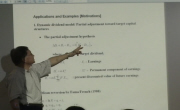돌날과 좀돌날 석기 연구는 후기구석기시대 문화편년에 있어 중요한 증거가 되고, 더 나아가 선사인들의 경제활동과 기술행위를 이해하는 핵심적인 정보를 제공한다. 우리나라에서 최초로 ...
http://chineseinput.net/에서 pinyin(병음)방식으로 중국어를 변환할 수 있습니다.
변환된 중국어를 복사하여 사용하시면 됩니다.
- 中文 을 입력하시려면 zhongwen을 입력하시고 space를누르시면됩니다.
- 北京 을 입력하시려면 beijing을 입력하시고 space를 누르시면 됩니다.

장리유적 돌날과 좀돌날 제작의 기술학적 재검토 -돌감, 제작방법과 떼기기술을 중심으로- = Technological approach to blades and micro-blades production at the Seokjang-ni site (Gongju-si, Korea)
한글로보기https://www.riss.kr/link?id=A102716183
- 저자
- 발행기관
- 학술지명
- 권호사항
-
발행연도
2015
-
작성언어
-
-
주제어
석장리유적 ; 돌날 ; 좀돌날 ; 기술학 ; 제작 연쇄공정 ; 돌감 ; 제작방법 ; 떼기기술 ; Seokjang-ni ; blade ; micro-blade ; technology ; raw material ; method ; technique
-
KDC
900
-
등재정보
KCI등재
-
자료형태
학술저널
-
수록면
54-83(30쪽)
- 제공처
-
0
상세조회 -
0
다운로드
부가정보
국문 초록 (Abstract)
돌날과 좀돌날 석기 연구는 후기구석기시대 문화편년에 있어 중요한 증거가 되고, 더 나아가 선사인들의 경제활동과 기술행위를 이해하는 핵심적인 정보를 제공한다. 우리나라에서 최초로 발굴된 석장리유적의 돌날과 좀돌날 석기는 연구사적으로 뿐만 아니라 후기구석기시대의 석기 기술체계와 기술전통을 규명하는데 매우 중요한 의미를 가지고 있다. 따라서 석장리유적의 돌날과 좀돌날 석기를 기술학적 접근 방법을 통해 제작 연쇄공 정에 따라 돌감, 제작방법, 떼기기술을 중심으로 재조명 하였다.
돌날과 좀돌날 제작 가운데 다양한 돌감의 획득과 경영 방식이 확인된다. 유적 인근 지역에 분포하는 반암은 일상 활동 중에 직접 획득하였고, 유적과 다소 떨어진 곳에 존재하는 유문암은 직·간접적으로, 흑요석과 처트와 같은 외래 돌감은 교환 방식으로 통해 유적으로 유입되는 등 돌날과 좀돌날을 생산하기 위한 여러 돌감 획득 방식이 있었다. 뿐만 아니라 획득된 돌감도 돌날과 좀돌날의 제작 연쇄공정에 따라 차별적으로 이용되기도 하였다.
돌날은 유적 내에서 후기구석기시대의 전형적인 제작방법에 따라 체계적으로 생산되었다. 몸체의 형태와 제작과정 중의 상황에 따라 적절한 능선손질 방식을 채택하여 몸돌을 마름질하거나 (재)손질하였으며, 돌날을 떼기 전 때림면을 적절하게 마련하거나 재생하기도 하였다. 사용된 떼기기술의 경우 몸체를 손질할 때는 돌망치 떼기가 이루어졌던 반면에, 석기제작자가 1차적으로 의도한 돌날은 무른 망치 직접떼기기술로 떼어졌다.
좀돌날은 돌날에 비해 보다 다양한 방법으로 제작되었다. 양면손질식, 새기개식, 밀개식, 원추·원통형식 등크게 4가지 제작방법이 확인되었는데, 이러한 다양성이 내외적인 환경과 제약에 따른 기술적 선택인지 아니면 시간에 따른 변화가 반영된 것인지에 대해서는 앞으로 층서에 따른 통시적 연구와 인근 유적과 비교를 통한 공시적 연구를 통해 밝힐 수 있을 것이다. 한편, 돌날과는 달리 좀돌날은 눌러떼기기술을 통해 생산되었는데, 몸체를 만드는 마름질과 재손질 과정, 좀돌날 떼기의 초기 단계에는 직접떼기가 사용되었다.
다국어 초록 (Multilingual Abstract)
Studies on blades and micro-blades are essential works for establishing the chronology of the Upper Paleolithic, and further provide important information for understanding economic activities and technical actions of the prehistoric people. This arti...
Studies on blades and micro-blades are essential works for establishing the chronology of the Upper Paleolithic, and further provide important information for understanding economic activities and technical actions of the prehistoric people. This article aims to re-examine chaîne opératoire, which include raw materials, production methods and knapping techniques on the basis of technological approach to blades and micro-blades from the Seokjang-ni site for comprehending technical system and tradition of lithic tools belonging to the Upper Paleolithic in the Korean peninsula.
Blades and micro-blades show procurement and management modalities of various raw materials. The Seokjang-ni people collected porphyritic rocks, which is distributed nearby the site, during daily activities, directly and indirectly procured rhyolite, which is distributed in the place little away of the site, and acquired distant raw materials including obsidian and chert in exchanges. These facts apparently show that they used various modalities for procuring raw materials to produce blades and micro-blades.
Moreover, various raw materials were processed selectively in accordance with chaîne opératoire.
Blades were systematically produced by the typical methods of the Upper Paleolithic. Lithic producers roughed out or (re)shaped blade cores by suitable crest-shaping in accordance with shapes of blank and processing conditions, or suitably made or rejuvenated striking platforms before flaking blades. Whereas producers shaped preforms by hard hammer percussion, blades that they intended were flaked by soft hammer percussion technique.
Micro-blades were produced more various methods than blades. It can be observed four methods including bifacial type, burin type, end-scraper type and conical/cylin-drical type. Further diachronic studies based on stratigraphy and synchronic studies by comparison with the sites located nearby places will reveal that these diversifications reflect either the technological selection under the environmental circumscriptions or chronological changes. On the other hand, differently from blades, micro-blades were produced by pressure technique. Direct percussion was adopted in roughing out for making platform, rejuvenating process, and the early stage for flaking micro-blades
목차 (Table of Contents)
- Ⅰ. 머리말
- Ⅱ. 돌날과 좀돌날의 돌감 획득과 경영
- Ⅲ. 돌날과 좀돌날의 제작방법과 떼기기술
- Ⅳ. 맺음말
- Ⅰ. 머리말
- Ⅱ. 돌날과 좀돌날의 돌감 획득과 경영
- Ⅲ. 돌날과 좀돌날의 제작방법과 떼기기술
- Ⅳ. 맺음말
동일학술지(권/호) 다른 논문
-
- 한국구석기학회
- 장용준(Yongjoon Chang)
- 2015
- KCI등재
-
- 한국구석기학회
- 이선복(Seonbok Yi)
- 2015
- KCI등재
-
- 한국구석기학회
- 한창균(Chang-gyun Han)
- 2015
- KCI등재
-
- 한국구석기학회
- 성춘택(Chuntaek Seong)
- 2015
- KCI등재




 스콜라
스콜라





